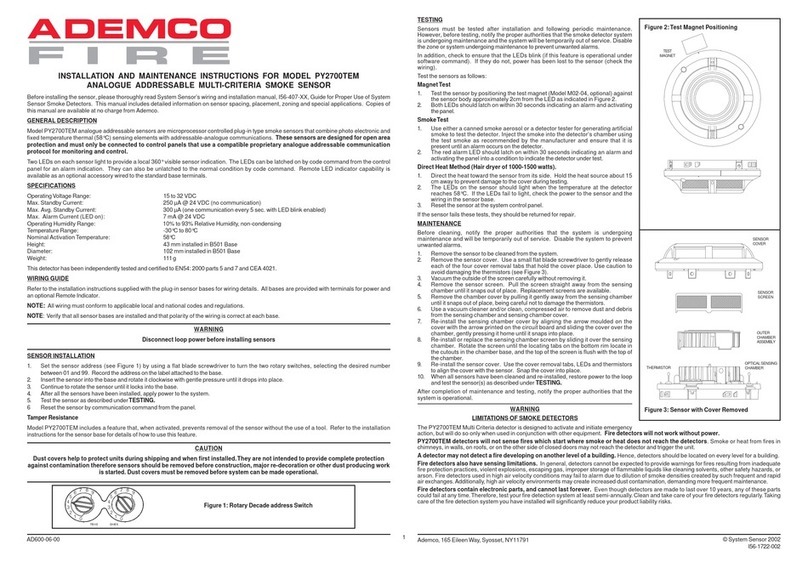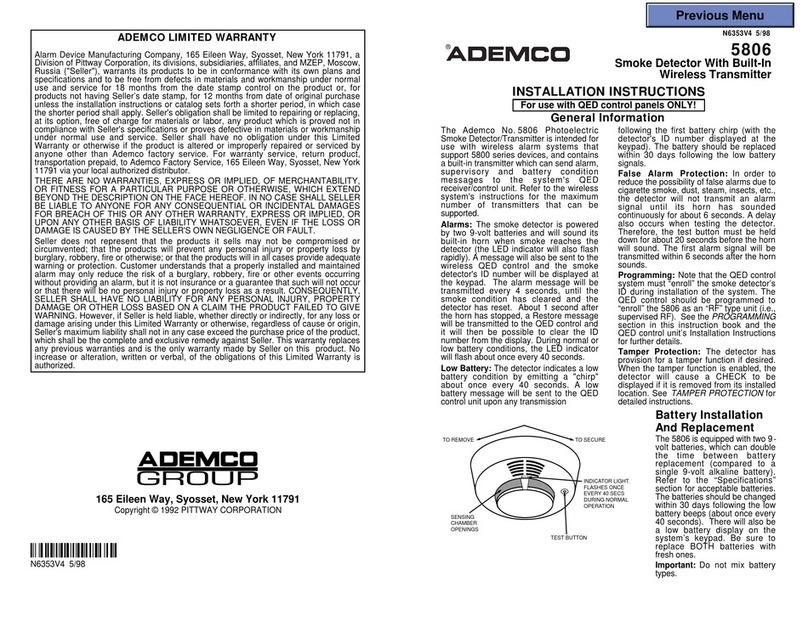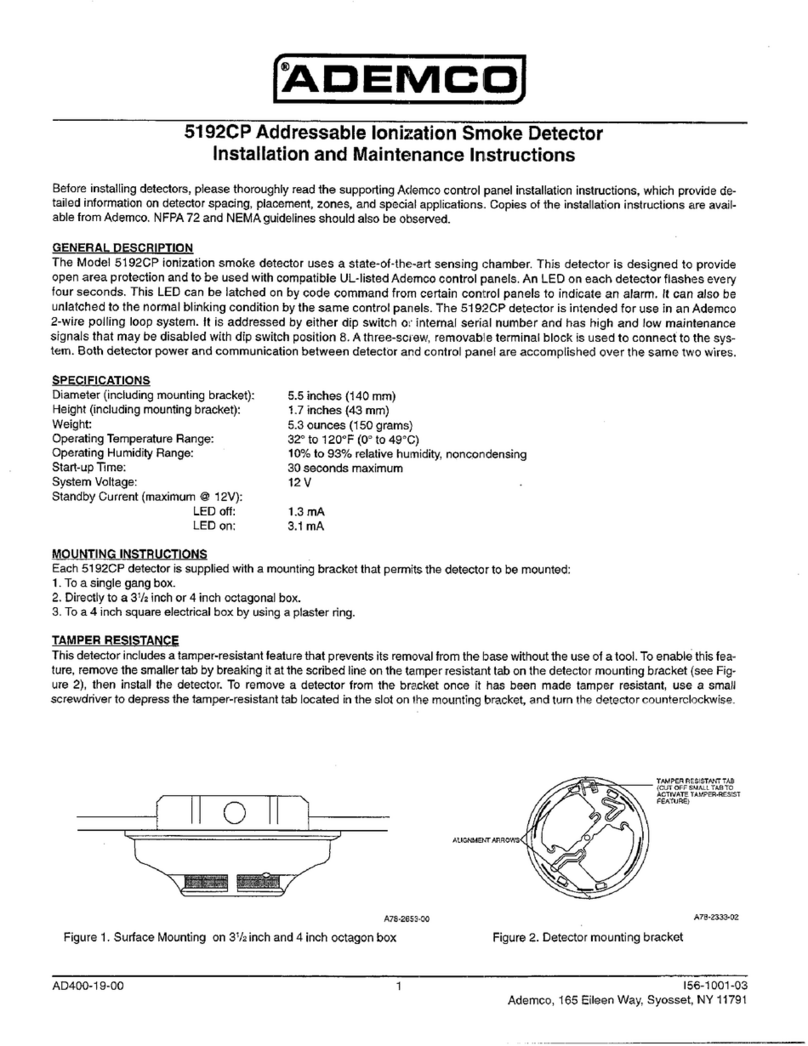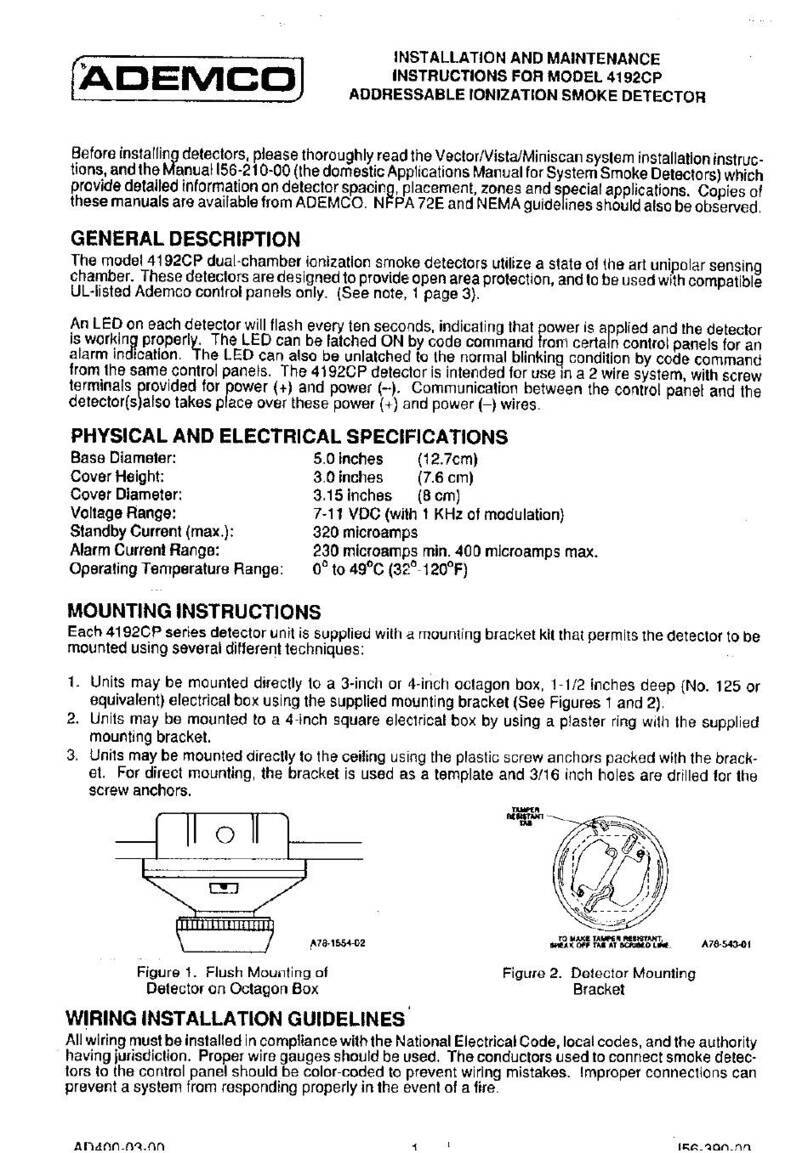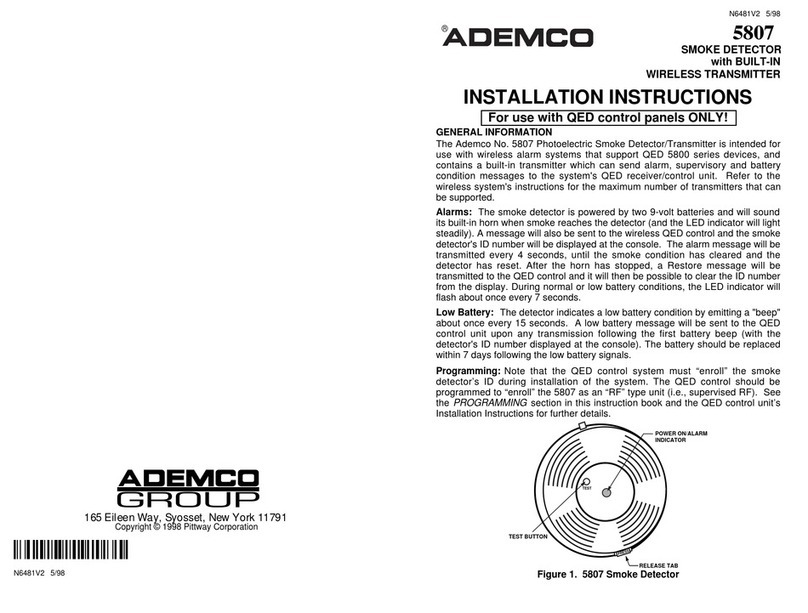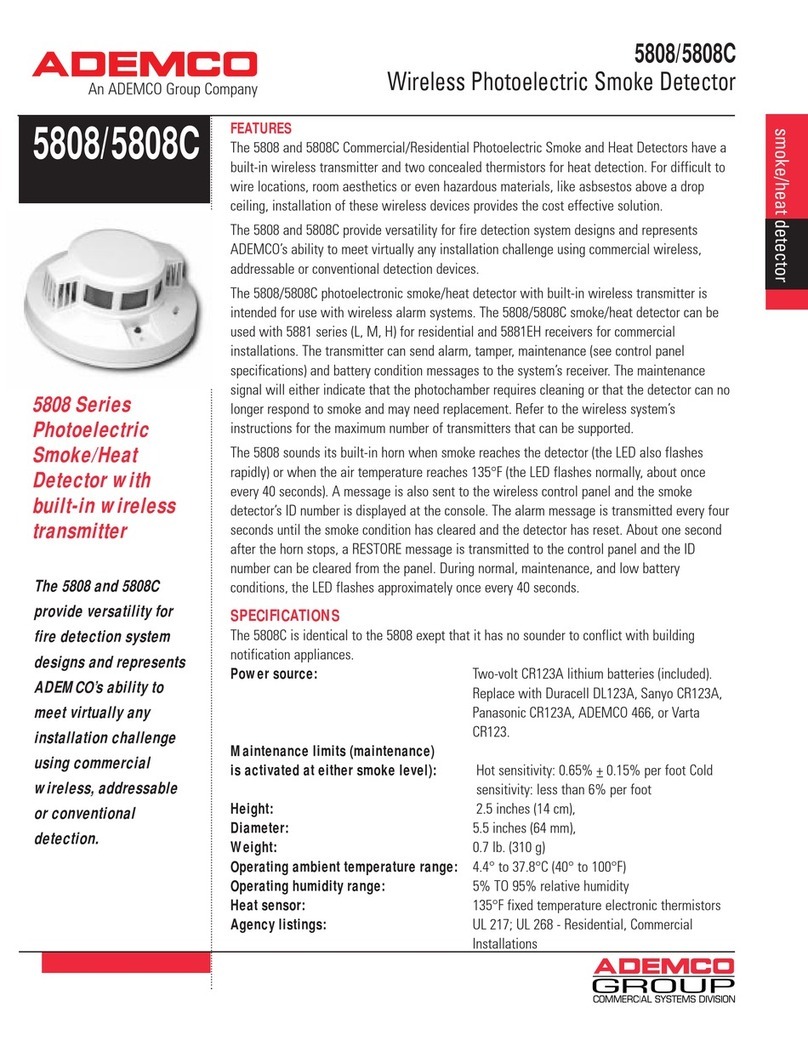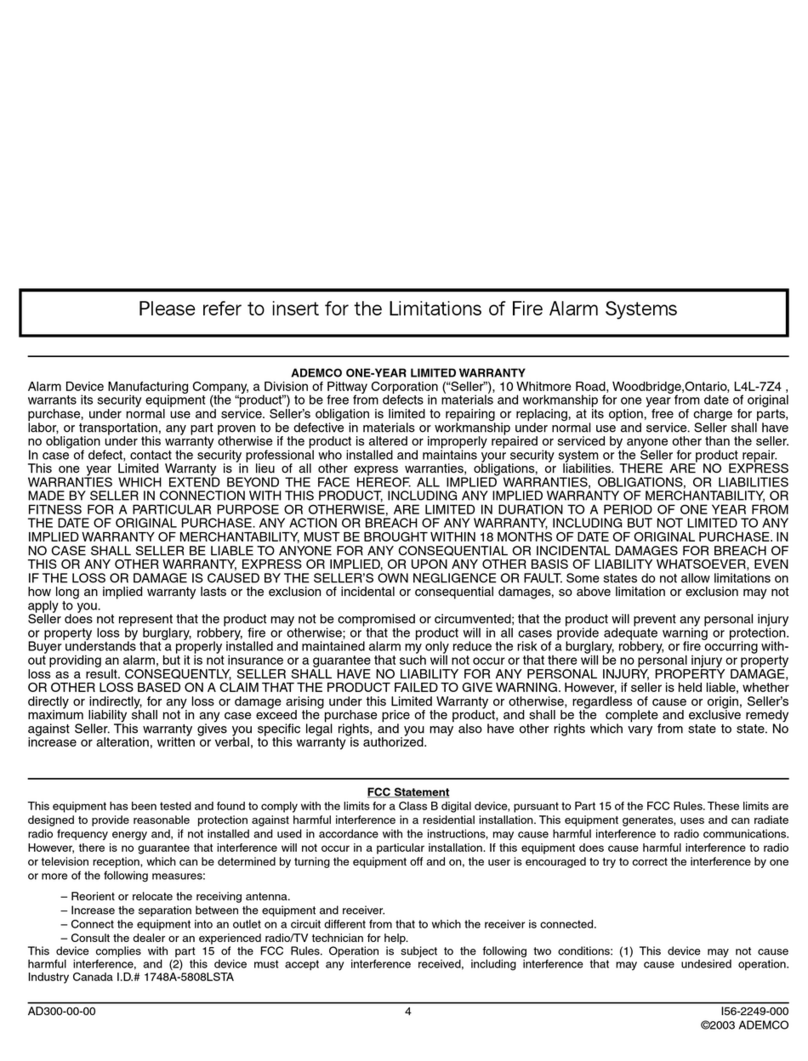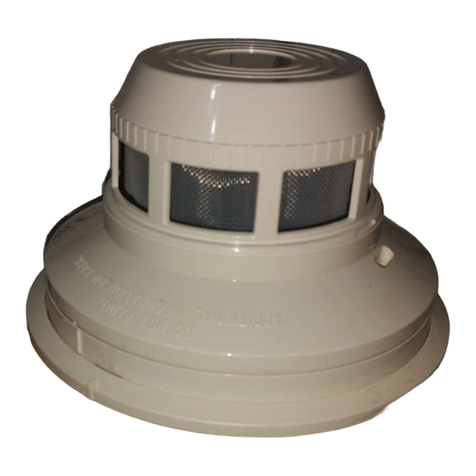
WARNING
LIMITATIONS OF SMOKE DETECTORS
This smoke detector is designed to activate and initiate emergency action, but will do so only when used in conjunction
with other equipment. This detector is designed for installation in accordance with NFPA standard 72, National Fire
Alarm Code.
Smoke detectors will not work without power. AC or DC powered smoke detectors will not work if the power supply is
cut off for any reason.
Smoke detectore will not sense fires which start where smoke does not reach the detectors. Smoke from fires in
chimneys, in walls, on roofs, or on the other side of closed doors may not reach the smoke detector and alarm it.
Adetector may not detect afire developing on another level of abuilding. For ttis reason, detectors should be lo-
cated on eve~ level of abuilding.
Smoke detectors have sensing limitations, too. Ionization detectors offer broad range fire-sensing capability, but
they are better at detecting fast, flaming fires than slow, smoldering fires. Photoelectronic detectors sense smoldering
fires better than flaming fires. Because fires develop in different ways, and are often unpredictable in their growth, nei-
ther type of detector is always best, and a given detector may not always provide warning of afire. In general, detectors
cannot be expected to provide warnings for fires resulting from inadequate fire protection practices, violent explosions,
escaping gas, improper storage of flammable tiquids like cleaning solvents, other safety hazards, or arson. Smoke de-
tectors used in high air velocity conditions may fail to alarm due to dilution of smoke densities created by such frequent
and rapid air exchanges. Additionally, high air velocity environments may create increased dust contamination, demand-
ing more frequent maintenance.
Smoke detectors cannot last forever. Smoke deiectors contain electronic parts. Even though detectors are made to
last over 10 years, any of theee parts could fail at any time. Therefore, test your smoke detector system according to
NFPA 72 at least semiannually. Clean and take care of your smoke detectors regularly. Taking care of the fire detection
system you have installed will measurably reduce your product tiability risks.
ADEMCO
ONE YEAR LIMITED WARRANTY
Alarm Device Manufacturing Company, aDivision of Piftway Corporation ~SelleP), 165 Eileen Way, Syosset, NY 11791,
warrants its security equipment (the “producY) to be free from defects in materials and workmanship for one year from
date of original purchase, under normal use and sewice. Seller’s obligation is limited to repairing or replacing, at its op-
tion, free of charge for parts, labor, ortransportafion, any part proven to be defective in materials or workmanship under
normal use and sewice. Seller shall have no obligation under this warranty othenvise if the product is altered or improp-
erly repaired or serviced by anyone other than the seller. In case of defect, contact the security professional who in-
stalled and maintains your security system or the Seller for product repair.
This one year Limited Warranty is in ~eu of all other express warranties, obhgations, or fiabilifies. THERE ARE NO EX-
PRESS WARRANTIES WHICH EXTEND BEYOND THE FACE HEREOF. ALL IMPLIED WARRANTIES, OBLIGA-
TIONS, OR LIABILITIES MADE BY SELLER IN CONNECTION WITH THIS PRODUCT, INCLUDING ANY IMPLIED
WARRANTY OF MERCHANTABILITY, OR FITNESS FOR APARTICULAR PURPOSE OR OTHERWISE, ARE LIM-
ITED IN DURATION TO APERIOD OF ONE YEAR FROM THE DATE OF ORIGINAL PURCHASE. ANY ACTION OR
BREACH OF ANY WARRANTY, INCLUDING BUT NOT LIMITED TO ANY IMPLIED WARRANTY OF MERCHANTABIL-
1~, MUST BE BROUGHT WITHIN 18 MONTHS OF DATE OF ORIGINAL PURCHASE. IN NO CASE SHALL SELLER
BE LIABLE TO ANYONE FOR ANY CONSEQUENTIAL OR INCIDENTAL DAMAGES FOR BREACH OF THIS OR ANY
OTHER WARRANTY, EXPRESS OR IMPLIED, OR UPON ANY OTHER BASIS OF LIABILITY WHATSOEVER, EVEN
IF THE LOSS OR DAMAGE IS CAUSED BY THE SELLER’S OWN NEGLIGENCE OR FAULT. Some states do not allow
limitations on how long an implied warranty lasts or the exclusion of incidental or consequential damages, so above hmi-
tation or exclusion may not apply to you.
Seller does not represent that the product may not be compromised or circumvented that the product will prevent any
personal inju~ or property loss by burglary, robbery, fire or otherwise; or that the product will in all cases provide ad-
equate warning or protection. Buyer understands that aproperly installed and maintained alarm my only reduce the risk
of aburglary, robbery, or fire occurring without providing an alarm, but it is not insurance or aguarantee that such will not
occur or that there will be no personal injury or property loss as aresult. CONSEQUENTLY, SELLER SHALL HAVE NO
LIABILITY FOR ANY PERSONAL INJURY, PROPERTY DAMAGE, OR OTHER LOSS BASED ON ACLAIM THAT THE
PRODUCT FAILED TO GIVE WARNING. However, if seller is held liable, whether dhectly or indirectly, for any loss or
damage arising under this Limited Warranty or otherwise, regardless of cause or origin. Seller’s mmimum fiabifify shall
be complete and remedy against Seller. This warranty gives you specific legal rights, and you may also have other rights
which vary from state to state. No increase or alteration, written or vetial, to ttis warranty is authorized.
AD400-12-00 4156-721-04
@Ademco 1994



